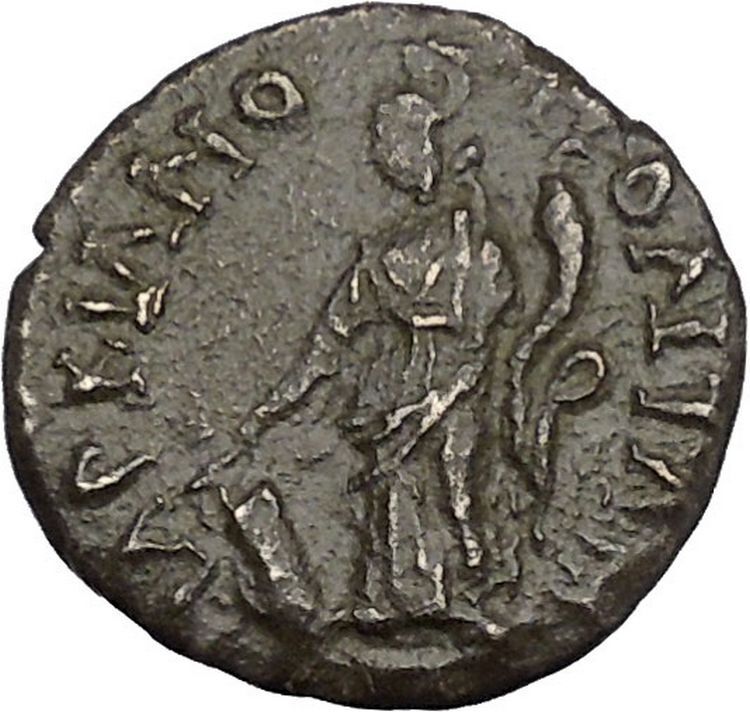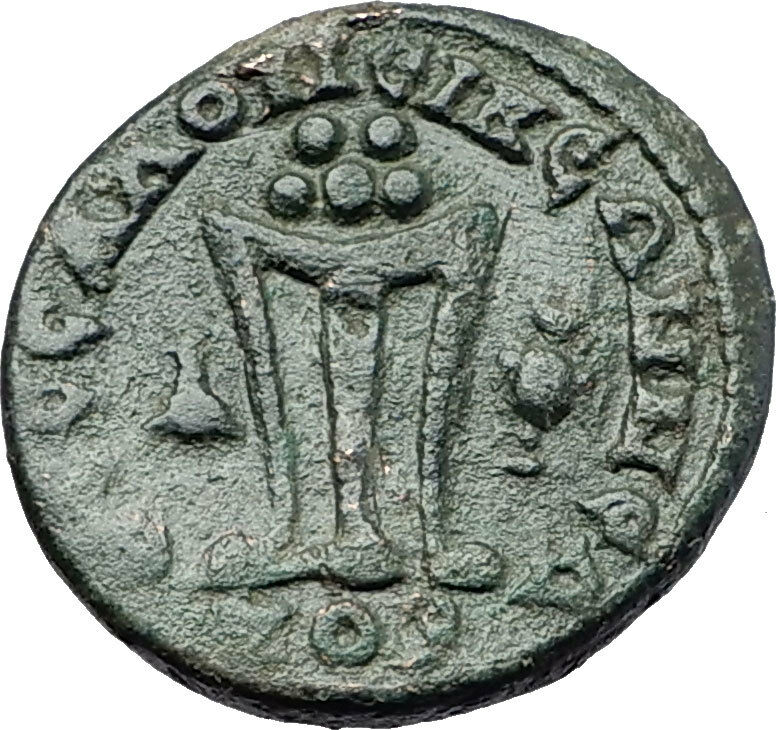|
Otacilia Severa – Roman Empress: 244-249 A.D.
Bronze 20mm (4.70 grams) of Cibyra in Phrygia
Reference: SNG Cop 301; SNG Tuebingen 4104
M • ΩΤAKIA • CЄBHPA • CЄ, draped bust right.
KIBV PΛTΩΝ, eagle standing facing with open wings on winged caduceus, head left.
The only one of this type I have seen CNG Auction 93, 2013-05-22, sold for $850 (better condition)..
You are bidding on the exact item pictured, provided with a Certificate of Authenticity and Lifetime Guarantee of Authenticity.
Kibyra or Cibyra (Greek: Κιβύρα), also referred to as Cibyra Magna, is an ancient city and an archaeological site in south-west Turkey, near the modern town of Gölhisar, in Burdur Province. It was the chief city of a district Cibyratis. Strabo says, that the Cibyratae are called descendants of the Lydians, of those who once occupied the Cabalis, but afterwards of the neighbouring Pisidians, who settled here, and removed the town to another position in a strong place, which was about 100 stadia in circuit.
It grew powerful under a good constitution, and the villages extended from Pisidia and the adjoining Milyas into Lycia, and to the Peraea of the Rhodians. When the three neighbouring towns of Bubon, Balubura, and Oenoanda were joined to it, this confederation was called Tetrapolis. Each town had one vote, but Cibyra had two votes; for Cibyra alone could muster 30,000 infantry and 2000 cavalry. It was always under tyrants, but the government was moderate. The tetrapolis formed under the leadership of Kibyra during the 2nd century BC, was dissolved by the Roman general Lucius Licinius Murena in 83 BC, at the time of the First Mithridatic War. Balbura and Bubon were assigned to the Lycians. The conventus of Cibyra, however, still remained one of the greatest in Asia. The Cibyratae had four languages, the Pisidian, the Hellenic, the language of the Solymi and of the Lydians. It is also the place where, according to Strabo, the Lydian language was still being spoken among a multicultural population around his time (1st century BC), thus making Kibyra the last locality where the culture, by then extinct in Lydia proper according to extant accounts, is attested. It was a peculiarity of Cibyra that the iron was easily cut with a chisel, or other sharp tool.
Strabo does not fix the position of Cibyra precisely. After mentioning Antiochia on the Maeander as being in Caria, he says, to the south the great Cibyra, Sinda, and the Cabalis, as far as Taurus and Lycia. Ptolemy places Cibyra in Great Phrygia, and assigns the three cities of Bubon, Balbura, and Oenoanda to the Cabalis of Lycia, which is consistent with Strabo.
The place is identified by inscriptions on the spot. The ruins cover the brow of a hill between 300 and 400 feet above the level of the plain. The material for the buildings was gotten from the limestone in the neighbourhood; and many of them are in good condition. One of the chief buildings is a theatre, in fine preservation: the diameter is 266 feet. The seats command a view of the Cibyratic plain, and of the mountains towards the Milyas. On the platform near the theatre are the ruins of several large buildings supposed to be temples, some of the Doric and others of the Corinthian order. On a block there is an inscription, Καισαρεων Κιβυρατων ἡ βουλη και ὁ δημος, from which it appears that in the Roman period the city had also the name Caesarea. The name Καισαρεων appears on some of the coins of Cibyra. A large building about 100 yards from the theatre is supposed to have been an Odeum or music theatre. There are no traces of city walls.
The stadium, 650 feet in length and 80 in breadth, is at the lower extremity of the ridge on which the city stands. The hill side was partly excavated to make room for it; and on the side formed out of the slope of the hill were ranged 21 rows of seats, which at the upper extremity of the stadium turned so as to make a theatre-like termination. This part of the stadium is very perfect, but the seats on the hill side are much displaced by the shrubs that have grown up between them. The seats overlook the plain of Cibyra. The seats on the side opposite to the hill were marble blocks placed on a low wall built along the edge of the terrace, formed by cutting the side of the hill. Near the entrance to the stadium a ridge runs eastward, crowned by a paved way, bordered on each side by sarcophagi and sepulchral monuments. At the entrance to this avenue of tombs was a massive triumphal arch of Doric architecture, now in ruins.
The elevation of the Cibyratic plain is estimated to be 3500 feet above the level of the sea. It produces corn. The sites of Balbura, Bubon, and Oenoanda, which is on the Xanthus, being now ascertained, we can form a tolerably correct idea of the extent of the Cibyratis. It comprised the highest part of the basin of the Xanthus, and all the upper and probably the middle part of the basin of the Indus, for Strabo describes the Cibyratis as reaching to the Rhodian Peraea. The great range of Cadmus (Baba Dagh), said to be 8000 feet high, bounded it on the west, and separated it from Caria. The upper part of the basin of the Indus consists of numerous small valleys, each of which has its little stream. Pliny’s brief description has been derived from good materials: the river Indus, which rises in the hills of the Cibyratae, receives sixty perennial rivers, and more than a hundred torrents.
Cibyra is first mentioned by Livy in his history of the operations of the consul Cn. Manlius, who approached it from the upper part of the Maeander and through Caria. He probably advanced upon it by the valley of Karaook, through which the present road leads from the Cibyratis to Laodicea on the Lycus. Manlius demanded and got from Moagetes, the tyrant of Cibyra, 100 talents and 10,000 medimni of wheat. Livy says that Moagetes had under him Syleum and Alimne, besides Cibyra. This Alimne may be identified with the remains of a large town on an island in the lake of Gule Hissar, which island is connected with the mainland by an ancient causeway. This lake lies in the angle between the Caulares and the river of Cibyra. The last tyrant of Cibyra, also named Moagetes, was the son of Pancrates He was put down by L. Licinius Murena, probably in 84 BCE, when his territory was divided, and Cibyra was attached to Phrygia.
Pliny states that twenty-five cities belonged to the Jurisdictio or Conventus of Cibyra; and he adds that the town of Cibyra belonged to Phrygia. This, like many other of the Roman political arrangements, was quite at variance with the physical divisions of the country. Laodicea on the Lycus was one of the chief cities of this Conventus. Under the Romans, Cibyra was a place of great trade, as it appears (Hor. Ep. i. 6. 33). Its position, however, does not seem very favourable for commerce, for it is neither on the sea nor on a great road. We may conclude, however, that the Roman negotiatores and mercatores found something to do here, and probably the grain of the valley of the Indus and the wool and iron of Cibyra might furnish articles of commerce. Iron ore is plentiful in the Cibyratis. We know nothing of any artists of Cibyra, except two, whom Cicero mentions (Verr. ii. 4. c. 13), who were more famed for their knavery than for artistic skill. Cibyra was much damaged by an earthquake, in the time of Tiberius, who recommended a Senatus Consultum to be enacted for relieving it from payment of taxes (tributum) for three years. In this passage of Tacitus (Ann. iv. 13), it is called civitas Cibyratica apud Asiam.
Three Greek inscriptions from Cibyra are printed in the Appendix to Spratt‘s Lycia. All of them contain the name of the city, and all belong to the Roman period. One of them seems intended to record a statue, or some memorial set up in honour of Lucius Aelius, the adopted son of Hadrian, and it mentions his being in his second consulship dating the inscription to 137.
External links
- Over 190 pictures of the classical town
 Marcia Otacilia Severa or Otacilia Severa was the Empress of Rome and wife of Emperor Marcus Julius Philippus or Philip the Arab who reigned over the Roman Empire from 244 to 249. Marcia Otacilia Severa or Otacilia Severa was the Empress of Rome and wife of Emperor Marcus Julius Philippus or Philip the Arab who reigned over the Roman Empire from 244 to 249.
Severa was a member of the ancient gens Otacilius who were people of consular and senatorial rank. Severa’s father was Otacilius Severus or Severianus, who served as Roman Governor of Macedonia and Moesia, while her mother was a member of gens Marcius or was related to the gens. According to sources she had a brother called Severianus, who served as Roman Governor of Lower Moesia between 246-247.
Little is known on her life before marrying Philip. In 234, Severa married Philip who served in the Praetorian Guard under Emperor Alexander Severus. Severa had two children with Philip: a son named Marcus Julius Philippus Severus or Philippus II (born in 238) and – according to numismatic evidence – a daughter called Julia Severa or Severina, who is never mentioned by the ancient Roman sources.
In February 244, Gordian III was killed in Mesopotamia. There is a possibility that Severa was involved in a conspiracy to murder Gordian. Philip became the new emperor who gave his young predecessor a proper funeral and his ashes were returned to Rome for burial.
Philip gave Severa the honorific title of Augusta. Their son was made heir of the purple. Sometimes Severa and Philip are considered as the first Christian imperial couple, because during their reign the persecutions of Christians had ceased and the couple had become tolerant towards the faith of the Christians. Through her intervention, she saved Bishop and Saint Babylas of Antioch from persecution.
In August 249, Philip had died in battle in Verona and Decius (emperor) became the new emperor. Severa was in Rome that time. When the news of Philip’s death had reached Rome, Severa’s son was murdered by the Praetorian Guard. The child died in her arms. Severa survived her husband and son and lived later in obscurity. Her later life is unknown.
|




 Marcia Otacilia Severa or Otacilia Severa was the Empress of Rome and wife of Emperor Marcus Julius Philippus or Philip the Arab who reigned over the Roman Empire from 244 to 249.
Marcia Otacilia Severa or Otacilia Severa was the Empress of Rome and wife of Emperor Marcus Julius Philippus or Philip the Arab who reigned over the Roman Empire from 244 to 249.




